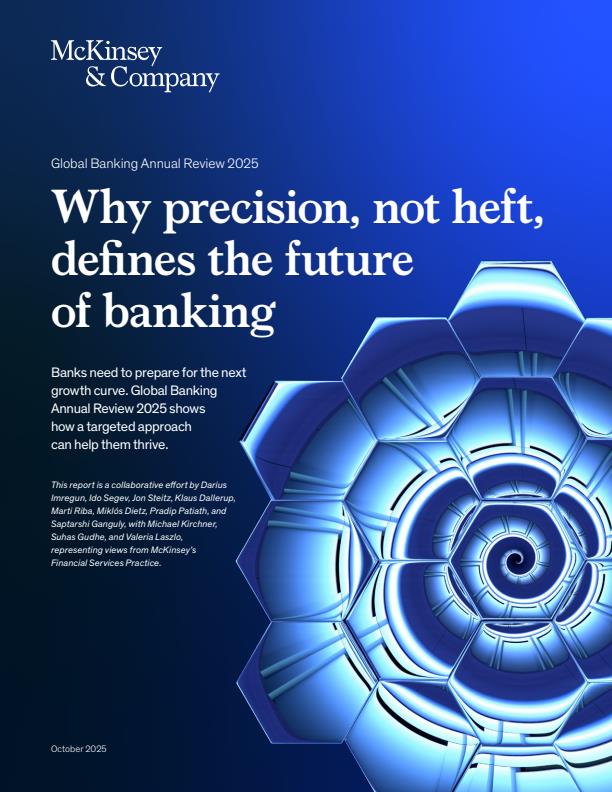One would be forgiven for assuming that the past few years have been mediocre for banking, given headlines about layoffs and worries about an economic slowdown. In reality, banks have racked up record after record without much fanfare or notice.
Between 2019 and 2024, funds intermediated by the global banking system, including traditional banks and nonbank providers, grew by $122 trillion, or about 40 percent, propelled by the global wealth of households and institutions. Banks’ revenues after risk cost reached a record $5.5 trillion in 2024, helping push the sector’s net income to $1.2 trillion, the highest total ever for any industry.
Yet capital markets remain skeptical about banks’ value creation potential: Valuation of the banking sector trails the average of all other industries by nearly 70 percent.
Why the disconnect? Banks’ recent performance has been buoyed by favorable conditions—a peak in the global wealth cycle, unusually strong revenue margins boosted by higher interest rates, and low risk costs—but these tailwinds are dissipating. ROE is barely clearing the cost of capital. The industry’s price-to-book ratio is 1, 67 percent below the average for other industries.
The peak before the plateau
After the peaks of the past few years, the banking sector may experience a reversion to the mean, with slower growth and mounting pressure on profitability. To catch the next growth curve, banks must shift from relying on traditional, time-worn approaches to precision strategies that generate value in more challenging conditions.
Different scenarios are possible, of course, depending on macroeconomic, technological, and regulatory outcomes. But the long-term pressures weighing on the sector are clear. The likely reversion to the mean will be driven not just by macroeconomic factors, such as interest rate movements and demographic shifts, but also by disruption stemming from advancements in AI, intensifying competition from nonbank providers such as fintechs, and evolving customer expectations.
Existing strategies haven’t succeeded. Banks spend about $600 billion a year on technology but productivity remains low. Broad customer segmentation hasn’t brought results. In capital efficiency, sweeping reallocations and broad balance sheet adjustments are insufficient. Chasing M&A deals to achieve scale and nothing else hasn’t delivered.
To thrive, banks need new solutions. Macro-focused, scale-driven strategies once promised resilience but no longer suffice.
Precision is the decisive differentiator, separating leading banks from slow movers and reshaping the industry’s performance curve.
The “precision toolbox,” applicable to banks of any size, revamps strategy across four core dimensions:
- Technology: focusing surgically on technologies with the greatest impact—even within agentic and gen AI—while scaling back investments that don’t improve workflows, customer engagement, or business models
- The new consumer: moving beyond broad segmentation to individualization (a “customer segment of one”), delivering hyperpersonalized, data-driven access to products and services that earn trust in an era of fading loyalty
- Capital efficiency: shifting from sweeping reallocations to micro-level balance sheet discipline—product by product, client by client, down to individual risk-weighted assets—to free up trapped capital with precision and put it to work where it earns more
- Targeted M&A: moving from scale for size’s sake to precision, pursuing deals that add reach in specific micromarkets or geographies, or that bring distinct capabilities in a specialized area
Precision, not heft, is the great equalizer. In the age of AI, even smaller banks can capture disproportionate rewards by embedding precision into every dimension of strategy. Our annual report (full Global Banking Annual Review 2025 available for download here ) covers all four elements of the precision toolbox described above, with an in-depth look at AI and the new consumer.
In 2024, the banking sector went from strength to strength. The rapid expansion of funds flowing through the banking system has consistently outpaced overall economic growth. Between 2019 and 2024, funds intermediated1 by the global banking system, including traditional banks and nonbank providers, grew significantly faster than global GDP (7.0 percent a year, on average, versus 4.8 percent).
This trend was driven by elevated interest rates, increased savings during the COVID-19 pandemic due to government stimulus and changing consumption patterns, and robust investment activity, which sent additional capital through banks and asset managers, increasing the volume of funds they intermediate. Over that period, retail funds managed by financial institutions increased 6.0 percent annually, and institutional funds grew 7.7 percent annually (Exhibit 1). Funds in the banking system originating from private capital experienced the fastest growth, expanding by 17.2 percent a year, underscoring private capital’s rising influence in global markets.2

A subcategory of intermediated funds, the global wealth of households and institutions, has been on an upward trend, helping to propel the banking industry’s revenue growth. Over the past five years, global wealth as a percentage of nominal GDP surpassed the 350 percent mark.
Moreover, the distributable capital, also known as free cash flow to equity, that banks generated in 2021–24 vastly exceeds the total for any other industry (Exhibit 2). Shareholders received a significant portion, but banks have also built up historically large reserves for potential investments and acquisitions.

The past three years have been very strong for banks, but have they seized the opportunity to transform the windfall into making their business models ready for the future? The capital market view suggests that maybe not enough banks have done so. Despite banks’ record-breaking recent years, the valuation gap between banking and other sectors persists (Exhibit 3).

Markets doubt the sustainability of banks’ recent highs. Complicating the picture are macroeconomic forces, including declining interest rates, shifts in technology and consumer behavior, and the steady siphoning of attractive profit pools by fintechs, private credit, and wealth managers. This confluence of factors could push banks’ ROE below the cost of equity in many markets.
The agentic AI era: Big gains, bigger disruptions
In an era of falling revenues, banks sorely need productivity gains and could potentially get them from AI. But AI is a double-edged sword, likely to bring cost savings as well as disruption. Agentic AI in particular has the potential to radically reshape banking—and not necessarily to the benefit of the industry as a whole. It could create unprecedented efficiencies and new customer value, but without decisive adaptation by banks, it stands to erode traditional profit pools.
Early adopters will be able to secure a lasting advantage over slow movers. Given these are still the early days of agentic and gen AI, it is imperative to use surgical precision to identify where these technologies can truly generate earnings impact, rather than piling into them because of the fear of missing out.
The magnitude of AI’s effect on banking will likely depend on two key factors: the extent to which banks can become fully agentic and radically lower the cost of operations, and the extent to which customers adopt AI to manage their financial affairs.
Our analysis includes nine scenarios defined by these factors (Exhibit 4). In our central scenario, which we estimate has a 30 percent likelihood of playing out, AI substantially reshapes both banking operations and consumer behavior.

Other scenarios appear less likely. For example, scenario C3, in which consumers fully delegate financial decision-making to AI agents and banks drastically reduce their head counts, hinges on two factors that are unlikely in the medium term: regulatory acceptance of agents autonomously executing transactions on customers’ behalf and AI’s ability to replicate senior-level decision-making. Still, even if consumers are required to give final approval to transactions orchestrated by AI agents, meaning these agents aren’t fully autonomous, such a model could cause major disruption to the industry, as seen in our central scenario.
The timing of disruption is uncertain. Nonetheless, we expect a breakout agentic business model to emerge in the next three to five years, creating a tipping point.
As AI is implemented across the banking industry, it could bring gross reductions of as much as 70 percent in certain cost categories. But because these savings will be partly offset by rising technology costs, we expect the net effect on banks’ aggregate cost base to be a 15 to 20 percent decrease (Exhibit 5).

The impact of these savings, while welcome, won’t last. As with earlier innovations, competition will likely erode the gains for banks and most of the benefits will accrue to customers over time.
Longer term, AI is likely to erode bank profitability as consumers start routinely using AI agents to optimize their finances (for example, automatically moving deposits into higher-yield accounts), which would reduce customer inertia and reshape industry economics. Agentic AI could disrupt deposits and credit card lending in particular by cutting through inertia. Today, $23 trillion of the global total of $70 trillion in consumer deposits sits in checking accounts with near-zero rates, while the remainder is parked in accounts that often pay relatively low savings rates, according to McKinsey Panorama data.3 If just 5 to 10 percent of checking balances migrated to top-of-market rates, an action that might be prompted by AI agents, that could reduce the banking industry’s total deposit profits by 20 percent or more.
The threat from third-party agents could be material. If banks don’t reposition their business models to adapt, over the next decade or so, bank profit pools globally could decline by $170 billion, or 9 percent.4 That’s enough to bring average returns below the cost of capital.
But the effects won’t be felt equally. AI pioneers could see return on tangible equity (ROTE) increase by up to four percentage points, using their lead to reinvent models and capture value. Conversely, slow movers are likely to see lower profits long term.
Adapting to the new consumer
Winning with consumers is also crucial. AI is shaking up how customers and banks interact, raising expectations for seamless, hyperpersonalized experiences, especially among younger generations.
Consumers are more digital, less loyal, and more deliberate in how they choose financial providers. After a consumer has been triggered to look for a financial product, the consumer decision journey (CDJ) typically begins with the initial consideration set (ICS), or the first set of banks the consumer thinks of. The consumer then moves to active evaluation, a stage in which banks can be added or removed. The journey can also involve a loyalty loop, in which clients buy new products from their bank without considering other alternatives, though that’s a lot less likely these days.
The CDJ for banking purchases has changed substantially. In the United States, for example, only 4 percent of new credit card applicants choose their existing bank without first exploring alternatives, down from 10 percent in 2018. The numbers for US checking accounts are even more striking, with 4 percent of openings coming from the loyalty loop, down from 25 percent in 2018 (Exhibit 6).

Instead, customers place increasing importance on the first few banks they consider in their purchasing journey, meaning that any bank that builds awareness in the right way can secure a place in the ICS and be positioned for success. Banks that are most likely to end up in the ICS typically excel in four key areas: achieving high awareness, for instance by investing media spending where it delivers the biggest impact; triggering action by using precision to amplify word-of-mouth recommendations, such as through data-driven referral programs; aligning messaging precisely with what customers value; and driving preference through primacy. Being a consumer’s primary bank (that is, the bank holding most of their funds or associated with most of their payment transactions) makes a bank three to four times as likely as a competitor to be included in the ICS for additional products, and twice as likely to cross-sell products.5
New types of businesses, such as aggregators, gen AI platforms, intermediaries, and embedded-finance providers, are further disrupting the consumer decision journey, exacerbating the decline in loyalty.
The consumer transformation has been driven by AI and mobile. Most consumers already use gen AI and expect their banks to provide these tools as well. More than half of consumers now use gen AI tools, and many consumers rely on models such as ChatGPT to help them manage their financial needs. But they are eager for banks to offer such tools as well: Most users would like their primary bank to offer AI solutions, and nearly all say they would eventually switch to another provider if their current bank didn’t keep up with this technological shift.6
Mobile has become the most widely used channel in banking, and its role will accelerate as gen AI becomes more embedded in financial services. Customers who engage through mobile already deliver significantly higher value for banks, reinforcing the strategic importance of this channel. Still, branches remain critical in many geographies, particularly for activities such as opening checking accounts.
Banks that integrate AI-powered insights with mobile-first, personalized experiences, blending digital ease with human connection, will define the next era of customer engagement. To succeed, banks need to win consumer mind share, embrace mobile as the gateway for engagement, and embed AI into customer journeys before challengers seize the advantage.
Precision can allow banks to better serve the less loyal, more digital modern consumer, who expects hyperpersonalized experiences and seamless, mobile-first integrated journeys, such as the ability to start a task on mobile and complete it at a branch without having to explain the issue again. Banks that can adapt to these changes and deliver precisely what customers want will be well positioned for success. If incumbents fail to respond, a new wave of AI fintechs could rapidly emerge to fill the gap.
The banking industry’s next growth curve won’t be won by scale but by precision. Leaders that embed precision into strategies involving technology, customer engagement, capital allocation, and M&A will capture outsize rewards, while slow movers clinging to the old playbook risk decline. In this new era, precision isn’t just a strategy—it’s the avenue to profitable growth. If banks can put the precision toolbox to good use, the sector’s massive valuation gap can begin to close, resulting in true value creation for the banks that get it right.
The full Global Banking Annual Review 2025 is available for download here.



